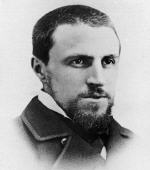
Gustave Caillebotte was born in 1848 to a wealthy family who had made their money in textiles and real estate during the redevelopment of Paris in the 1860s.
In 1875, wishing to make his public debut, he submitted a painting to the Salon jury, which rejected it. That work was probably the Floorscrapers, which Caillebotte then decided to exhibit in a more hospitable environment, that of the second Impressionist group exhibition of 1876. His work, highly acclaimed, stole the show and helped to make the second exhibition far more of a popular success than the first.
Wealthy and generous, Caillebotte financially supported his Impressionist friends by purchasing their works at inflated prices and underwriting many of the expenses encurred for the exhibitions.
Caillebotte was a painter of great originality. Like the Impressionists, Caillebotte pursued an instant of vision, recording it with a fullness of truthful detail. Caillebotte, however, attempted to portray the rhythms of an industrial society with his regimented figures and the clock-like precision of his Paris. In this aspect, he was very much like the Realists.
In 1876 he drew up a will providing money for an Impressionist exhibition to be held after his death, and bequeathing his collection of Impressionist paintings to the State. This bequest was made on the condition that the paintings should first be exhibited in the Luxembourg (the museum dedicated to the work of living artists), and later to the Louvre. He intended that the State should not hide the paintings away in an attic or provincial museum. His brother Martial along with Renoir were entrusted with making sure the provisions of his will were carried out.
Gustave Caillebotte died in 1894.